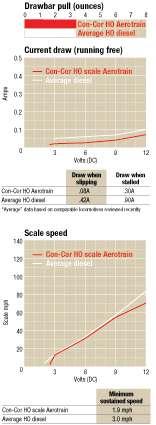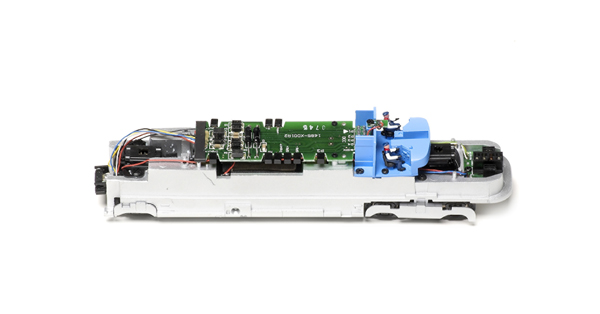The sleek locomotive has an unusual three-axle drive with a pair of traction tires that make it surprisingly powerful. It has a printed-circuit (PC) board with a socket and jumper plug and there’s room inside for a small Digital Command Control (DCC) decoder.
All of the lighted passenger cars include interior details and ride on single-axle trucks
General Motors introduced a pair of Aerotrains to the public in 1955, and these demonstrators logged over 600,000 miles traveling from coast to coast. Then they were tested in regular service operating as Atchison, Topeka & Santa Fe’s San Diegan (1956), New York Central’s Great Lakes Aerotrain (1956), the PRR’s Pennsylvania Aerotrain (1956), and the Union Pacific’s City of Las Vegas (1957). Electro-Motive built a third LWT12 to lead the Chicago, Rock Island & Pacific’s lightweight Talgo Train, the Jet Rocket (1956).
In 1958, EMD sold the original consists to the Rock Island. Retired in 1965, both trains now reside in railroad museums.
Concealed latches at the front of the fuel tank and just ahead of the rear truck hold the body shell on the frame. Gently inserting a pair of toothpicks between the chassis and the body at these points will release the latches for easy access.
The locomotive has a die-cast metal chassis that provides most of the model’s 16-ounce weight. A five-pole can motor with brass flywheels is inset into the fuel tank with a PC board on top. Acetal plastic universals and drive shafts link the motor to the truck gearboxes, which drive all three axles.
The lead truck is an EMD four-wheel Flexicoil switcher truck with removable skirts covering the side-frames. The single-axle rear truck has some flexibility to follow curves. All of the nickel-silver wheelsets have RP-25 contour wheels mounted on split axles, so internal contacts in both trucks pick up current from all of the wheels.
Our sample started moving on 2.5 volts at only 1.9 scale mph and reached a top speed of 70.3 mph at full throttle. That’s under the prototype’s 100 mph maximum speed. The model’s 3.4 ounce drawbar pull should be sufficient to haul a full nine-car consist.
This locomotive has superb lighting effects that cleverly repro-duce the prototype’s nose lights. Light beams from a group of LEDs are reflected through colored lenses to illuminate the unique headlights and the side number boxes.
The underbody is fully enclosed with excellent “possum belly” baggage doors. Sheet metal weights in the bottom of each 4-ounce car produce a low center of gravity.
Each car rides on a pair of single-axle trucks that have a small amount of play to compensate for tight model curves. Each wheelset picks up current from the track.
Working full-width diaphragms and electrical connectors replace the traditional car ends. Each diaphragm is mounted on a vertical steel pin so it can swing from side to side, and concealed magnets hold the striker plates together so they don’t separate on sharp curves.
All of the cars must be oriented with the vestibule forward (like the prototype) so the proper electrical connections can be made as the train is coupled together. These connectors complete the train’s electrical circuits and serve as couplers. There is no provision for conventional couplers.
A small Soundtraxx decoder will fit, but finding a place for the speaker and sound chamber is a challenge. Con-Cor has a special full-function sound decoder and speaker in production just for the Aerotrain. This add-on system is concealed in a modified coach that includes a large speaker and an extension cord that plugs into the locomotive’s DCC socket.
Adding any decoder uncovers a neat surprise: the model has a built-in circuit that makes the center headlights flash alternately when the DCC horn function is activated.
Con-Cor’s new Aerotrain is an impressive model that captures its prototype’s unique look and details. With its powerful, smooth-running mechanism, this train can easily be expanded to include the full nine-car consist.
Price: $429.98 per set (engine,two coaches, and observation car); three add-on coaches,$219.98
Manufacturer
Con-Cor International
8101 E. Research Court
Tucson, AZ 85710-6758
http://all-railroads.com/
Description
Powered plastic and metal passenger train
Road names
Atchison, Topeka & Santa Fe; Chicago, Rock Island & Pacific; General Motors
Demonstrator; New York Central; Pennsylvania RR; Union Pacific; and undecorated (painted silver, no lettering)
Diaphragms between cars
Eight-pin socket for a Digital
Command Control decoder
Electrical pick-up on all cars
Five-pole skewed armature
motor with dual flywheels
Flashing front headlights (in DCC
horn mode)
Interior details and lighting
Painted crew figures
Reversing headlights and
observation car backup lights
















